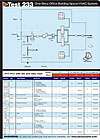
OWNER'S PROJECT REQUIREMENTS AND BASIS OF DESIGN
For April’s “Back2Basics” and “HVACR Designer’s Tips,” the HVAC system will be based on the 2007 ASHRAE Handbook - Applications, Chapter 3, “Commercial and Public Buildings.” The majority of HVAC systems are decentralized, and for this application, this month’s HVAC system is a standard decentralized system installation. Commercial and public building applications include:- Dining and entertainment centers;
- Office buildings;
- Bowling centers;
- Communication centers;
- Transportation centers;
- Warehouses;
- Other public spaces (refer to the 2007 ASHRAE Handbook - Applications, Chapter 3 [arenas, stadiums, etc.]).
- 30,000 sq ft, single-story office building;
- 40 Btuh/sq ft;
- 1,200,000 Btuh heating output and 1,500,000 Btuh input;
- 1,500 cu ft of gas at 0.4 in. gas pressure;
- 400 sq ft/ton;
- 75 tons cooling with two compressor andand two stages of capacity control per compressor;
- 1.1 cfm/sq ft;
- 33,000 cfm supply air at 4.0 in. total static pressure;
- 15% minimum outdoor air (4,650 cfm);
- No equipment redundancy.
- 65°F discharge air in the heating season
- 55° discharge air in the cooling season
- 5° outdoor air in the heating season
- 85° outdoor air in the cooling season
- 70° space temperature, occupied period, in the heating season
- 60° space temperature, unoccupied period, in the heating season
- 76° space temperature, occupied period, in the cooling season
- 82° space temperature, unoccupied period, in the cooling season
- No space humidity control
- No space pressure control
- Occupancy shall be Monday thru Friday, 6 a.m. to 6 p.m.
- Unoccupied cycle shall be Monday through Friday, 6 p.m. to 6 a.m., and Saturday and Sunday 24 hrs.
BAS Control and Monitoring Points
- OATT-1 outdoor air temperature transmitter (drybulb and wetbulb)
- MAT-1 mixed air temperature transmitter
- TT-1 discharge air temperature transmitter
- TT-2 return air temperature transmitter (dry bulb and wetbulb)
- ST-1 space temperature transmitter
- SD-1 duct smoke detector
Engineering in the Design Phase
- Unless the system selection is obvious, the designer should refer to Chapter 1 of the 2004 ASHRAE Handbook - Systems and Equipment for a refresher course on owner project compliance, goals, and basis of design (BofD). Working with the client, the design engineer should assist in developing the owner's project requirements (OPR) and the BofD design criteria. Refer to “Introduction” document for this information.
- Capacities, distribution, and sustainability can be drawn upon from past experience and rules of thumb to begin the process, and revisited later in the design phase by firming up the actual calculations and equipment selections.
- Next, the designer should always start the concept with a system flow diagram (e.g., Cx-3 ATC/FPT software program) along with the associated sequence of operation.
- Refer to “HVACR Designer’s Tips” and the upcoming June 2008 “Application Checklist” for additional information.
Third-Party Cx and TAB Engineering in the Design Phase
- The commissioning engineer should review the OPR and BofD, as well as the specific design criteria, for project compliance.
- The TAB engineer should review the design engineer’s construction documents prior to issuing the contract documents for bid to ensure there are adequate flowmeters, volume dampers, and balancing valves to achieve air and water balancing. In addition, the TAB engineer should review the design engineer’s air static pressures and water pump heads to ensure flows can be set without a sheave change and/or introduction of excessive pump head at pump discharge.
- The commissioning engineer will write the commissioning plan and incorporate it into Division 18000 of the contract specification, assuming Division 17000 is building automation.
- System flow diagrams should be use to create the overall ATC/FPT checklists and should be inserted into the contract specification
- Refer to Commissioning 1-2-3™ for complete commissioning process and specific documents.
- The commissioning engineer and TAB engineer will review the design documents for accessibility to equipment, ability to adjust and balance the systems, and commissionability.
- The commissioning team for this month’s application should include the commissioning engineer, the owner’s project manager, facility engineer, the construction manager’s commissioning coordinator, and the TAB engineer. If the project is to be D-B, include the mechanical contractor, the BAS contractor, and electrical contractor.
- The TAB engineer will write the TAB plan and incorporate it into Division 19000 of the contract specification.
- The TAB engineer should document all operating data on system flow diagrams that will be used (submitted in the shop drawing phase) during the actual air and water balancing.
